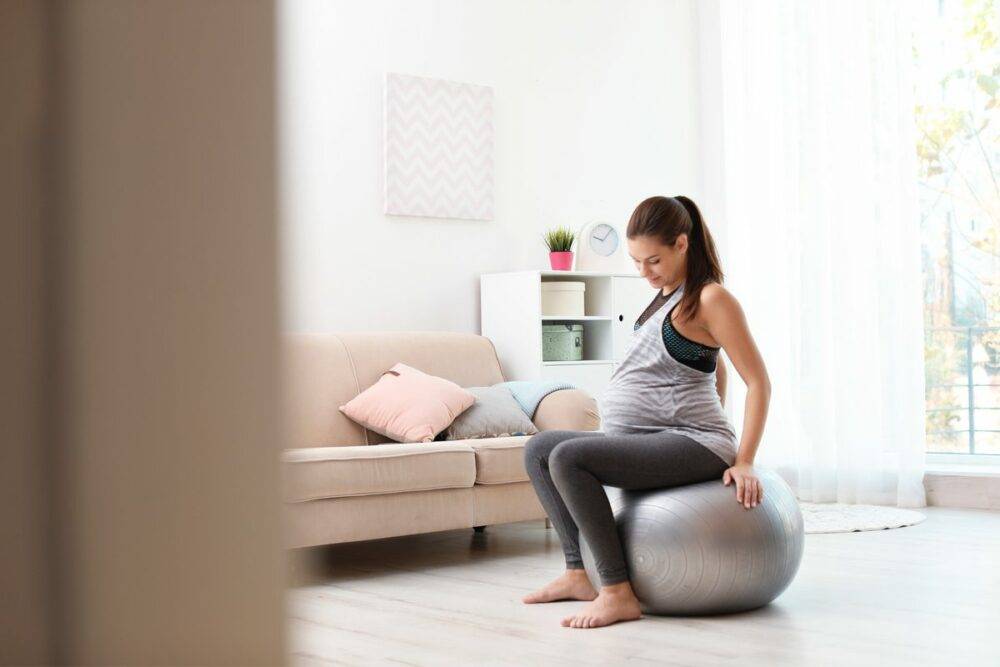Pelvic pain during pregnancy is common and can range from a dull ache to a sharp and shooting pain during movement. This uncomfortable pregnancy symptom is often written off as “normal,” which can be incredibly frustrating when you’re struggling with basic tasks like walking, putting pants on, and squatting to pick up your kids. It can also put a huge damper on any exercise you were doing because everything may seem to exacerbate the pain. While pelvic pain, or symphysis pubis dysfunction (SPD), is common for many during pregnancy, there are things you can do to help ease the pain and adapt movement to be more comfortable.
What is pelvic pain and why am I experiencing it?
Pelvic pain is usually felt fairly deep and can range from a dull ache to sharp pain. It can be constant, come and go, or be exacerbated by certain movements or exercises. Pelvic pain can sometimes start early in the second trimester with first pregnancies, and sometimes earlier in subsequent pregnancies, but everyone is different. Pelvic pain may also show up earlier in twin or multiples pregnancies because the babies are about the weight of a full-sized singleton around 28 weeks.
The cause of this type of pain isn’t really known, but it is generally due to excessive movement at the pubic symphysis — the cartilaginous joint that attaches the left and right sides of the pubic bone. The prevalence of this pain during pregnancy could be due to several factors, including hormones, extra pressure on the pubic symphysis joint due to a growing baby, and overall muscle support.
What can I do about pelvic pain?
Many women want to know what to do about this pelvic pain, but upon visiting their healthcare providers, the pain is often written off as normal and something that will resolve after birth. But you shouldn’t have to suffer through the pain when you can potentially do something to lessen it. I suggest an approach that looks at daily movement patterns, modifying exercise routines, and strengthening muscles to support the pelvis because it can lend better long-term results.
First and foremost, I recommend women suffering from pelvic pain make an appointment for an evaluation with a pelvic floor physical therapist if they have access to one. They can assess your pelvic floor and surrounding musculature to give you a better idea of what may be causing your pelvic pain and suggest a treatment approach. You can find one in your area using this link.
If you are experiencing pelvic pain during exercise and would like to continue exercising comfortably throughout your pregnancy, it may be worth it to work with a personal trainer or athletic coach who is trained in pregnancy and postpartum fitness and who is educated on working with people with pelvic pain. You can search for specialists in your area or even someone who works remotely, using the same link above.
Here are some other tips for managing pelvic pain during exercise and daily life:
• Adjust your stride length during walking.
• Sit or rely on support to put on pants rather than standing. Annoying, yes, but this can help tremendously if standing on a single leg hurts.
• Adjust single-leg movements, like lunging. Many people would recommend to completely stop doing single-leg exercises when you’re experiencing pelvic pain. However, single-leg loading is a very functional and important task. I often find that balancing out the sides by loading a single leg in a way that doesn’t cause pain can be very helpful for managing pelvic pain.
• Hold a small ball between your knees when squatting, squat down to tap a bench or chair thus reducing the range of motion, or use a mini band around your knees to push out on and give feedback during a squat. If you’re experiencing pain during squats in everyday life — like when picking up your kids — try putting one foot in front of the other to squat or bend. This can help offload the pelvis and give you support when you need it.
• Pelvic floor down training (done by learning how to relax the pelvic floor), adductor stretching, and glute strengthening can be tremendously helpful when managing pelvic pain. The glutes and the pelvic floor are best friends. Often when we’re experiencing pelvic symptoms, we need to be looking at what the glutes are doing and show them a little love.
I hope these tips are helpful for reducing pelvic pain during your pregnancy. If you are experiencing pelvic pain, know that you most certainly aren’t alone. So many other moms deal with this too! And while pelvic pain is common during pregnancy, it doesn’t have to be something that you just have to live with until birth. You deserve to feel better.


